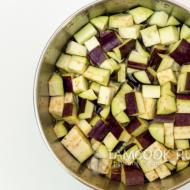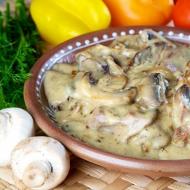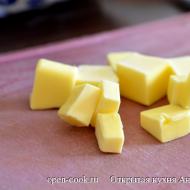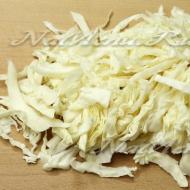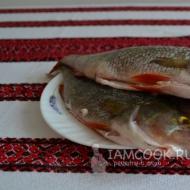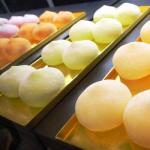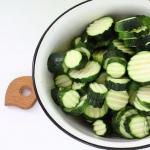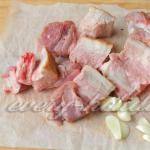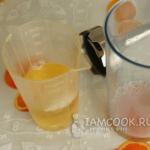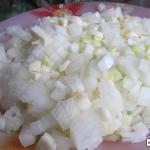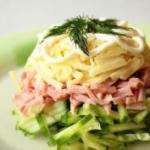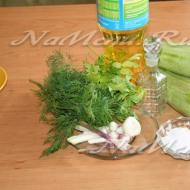
Grape wine proportions of adding sugar and water. Recipes for wine from grapes and water. Cleaning wine from impurities
Winemaking and the process of preparing wine from grapes is a real art, the rules and basic secrets of which must be learned over many years. If you know some cooking conditions and follow the instructions, you can make high-quality grape wine with your own hands. It is clear that this will not be a masterpiece, but if all conditions are carefully observed, it will be guaranteed to be better than those wines that are usually purchased in stores.
Below we will present to your attention the process of preparing wine from white and red grapes and cherries in ordinary home conditions. All recipes are quite simple, often the cooking process requires only sugar, berries and a little water, as well as following a certain technology.
Before you start preparing wine from cherries or grapes, you should make sure that the equipment for preparing wine and containers are prepared. To avoid contaminating the juice with various pathogenic bacteria, such as mold, such containers should be as dry and crystal clear as possible.
Bottles, barrels and buckets can be smoked with sulfur. This is what is usually done in modern industry. You can also rinse all containers with boiled water, and then wipe everything very thoroughly with a dry cloth.
After preparing the necessary containers, you will need to prepare the necessary ingredients. Among them are:
- 10 kg of grapes;
- Approximately 100-200 grams of sugar in proportion to a liter of juice;
- Water in the amount of 100 ml, but sometimes it is not required.

Water is needed if the juice is very sour. In this case, it is important to remember that the use of sugar itself reduces acidity. In all other cases, the process of preparing and diluting wine with water significantly worsens its overall taste, so it is not recommended to do this.
The most popular grape wine recipe
Processing and harvesting must be done in such a way that the yeast necessary for fermentation remains on the cherry or grape fruits. To do this, berries should be removed from the bushes in dry weather. There was no rain for about two or three days before harvest.
The step-by-step process of making wine from grapes at home will be correct if you take only fully ripe berries. If the grapes are unripe, if there is a lot of acid in them, and fermentation begins in the berries, after a certain time it can spoil all the squeezed juice, that is, the wort. In addition, it is strongly recommended not to collect and add carrion to the collection, as it gives the wine an unpleasant taste, reminiscent of the taste of earth. All picked berries should be processed within no more than two days. Next, the following sequence of actions is carried out:
- All harvested grapes must be very carefully sorted, all leaves and twigs, as well as rotten, unripe or moldy berries must be removed.
- After this, the berries need to be crushed, and the resulting pulp and juice placed in an enamel bowl. A plastic basin is also suitable.
- The container is filled with the mixture to approximately three-quarters of its volume.
- You need to crush the berries with your hands, so as not to damage the seeds. They contain substances that give wine a bitter taste. If there are a lot of fruits, they should be crushed as carefully as possible with a special wooden rolling pin.

It is best to use wooden devices, since contact with metal often causes severe oxidation, which significantly impairs the taste of the wine. For this reason, the berries are always kneaded with wooden spoons and rolling pins or by hand, and the resulting composition is placed in an enamel bowl or pan; you can also use containers made of special food-grade plastic or wood.
The container with pulp must be covered with clean material to protect the composition from flies. All this is placed for about 3 days in a dark place where the constant temperature is 25 degrees. After 15-20 hours, the juice starts the fermentation processes, and a cap of collected skin immediately appears on the surface. It needs to be beaten a couple of times a day, constantly stirring the pulp with your hand or a stick. If this process is not carried out, the composition can turn sour quite quickly.
The process of preparing and extracting juice
After about three or four days, the pulp becomes an order of magnitude lighter, a slightly sour smell appears, and a slight hiss is heard. All this suggests that fermentation has started successfully, which means that it is time to squeeze out all the resulting juice.
The topmost layer, which consists of the peel, must be collected in a separate container and carefully squeezed with a special press or by hand. The entire volume of juice that is drained from the sediment, as well as the mixture that is pressed from the pulp, must be filtered through previously prepared gauze. You need to pour from one container to another two or three times. Such transfusion not only effectively removes small particles, but also saturates the juice with oxygen beneficial to the wine. All this ensures the normal functioning of wine yeast, and at the very initial stage.
When working with unripe fruits or fruits growing in northern latitudes, it is often necessary to add water. The amount of water is in the proportion of 100 ml per liter, no more, as a large amount of water will spoil the overall quality of the wine. It is much better to leave some increased acidity in the wine, since during normal fermentation the overall concentration of acids decreases slightly.
The resulting pure juice is used to fill containers intended for fermentation. Filling is carried out to a maximum of 70% of the total volume. For this purpose, it is better to use bottles made of glass, and jars are also suitable if the volume of the bottles is insufficient.

Water simple shutter
To prevent homemade wine from becoming sour, it must be protected from constant contact with air. This ensures the release of a by-product from fermentation, that is, carbon dioxide. This process can be carried out by installing a structure called a water seal on a special container with juice. A classic water seal made of a tube, a jar and a lid is ideal. A simple medical glove with a hole made in one finger has proven itself relatively well.
The design features of the water seal are not particularly important, but if convenience is achieved, it is better to put a regular classic water seal on the bottles used, and put a seal or glove on the containers themselves.
Active initial fermentation
Immediately after installing the water seal, all used containers in which the juice has already fermented will need to be provided with the most comfortable temperature conditions. The optimal temperature regime for homemade red grape wine in this case is the range from 22 to 29 degrees. For white, a mode up to 22 degrees is suitable. It is strictly forbidden to allow the temperature to drop below 15 degrees. If this is allowed, the fermentation of the yeast will stop, that is, the sugar will not be converted into alcohol.
Sugar addition process
There are several features and patterns regarding how sugar should be added. It is worth highlighting the following requirements:
- 2% sugar in grape juice gives approximately 1% alcohol in the finished wine drink.
- In almost all regions of the country, the total sugar content of grapes much less often exceeds 20%. Without added sugar, the wine can turn out with zero sweetness, but with 10% strength.
- On the other hand, the maximum possible strength of home-made wine is approximately 14%, usually 12%. If this alcohol concentration is exceeded, the yeast will immediately stop working.
It is impossible to determine the initial sugar content of grapes under normal home conditions without the use of a special device. It is called a hydrometer. Many people believe that it is possible to rely on numerous average values for varieties, but this is also ineffective, since it will be necessary to obtain data on the level of sugar content of the selected variety in a particular climatic zone. In areas that are not wine-growing areas, no one usually makes such complex calculations; for this reason, one has to focus on the taste characteristics of the wine. It should be sweet, but not too much.
In order to maintain an optimal level of fermentation throughout the preparation of wine, the total sugar content of such must should not be more than 20%. To ensure this important condition, sugar is added in parts, that is, fractionally. After fermentation begins, the wine should be tasted. As soon as the taste of the wine becomes sour, as soon as the sugar has been processed, you will need to add sugar in the amount of 50 grams per liter of juice formed. For this purpose, approximately two liters of wort are poured into a separate container, and sugar is diluted in it. Only after this the resulting syrup is poured back into the bottle or barrel.

A similar procedure is repeated approximately three times and must be carried out in the very first 14-21 days of fermentation. As soon as the overall sugar content decreases very slowly, this will be proof that there is enough sugar.
Directly depending on the general temperature regime, the amount of sugar and the general activity of yeast, the fermentation time of wine prepared at home is approximately 50 days.
Important! If fermentation does not stop even after 50 days after installing the water seal, in order to avoid the appearance of a bitter taste, it is worth pouring the wine into another container so that there is no sediment. The grape juice is also placed under a water seal and fermented under the same conditions.
Wine maturation
The time during which the final taste is formed lasts approximately 60-360 days. Longer aging of homemade grape wine is not advisable, since it does not improve the basic properties of the drink.
The container with wine, preferably filled to the very top, is again placed under the water seal or very tightly closed with a lid. Wine should be stored in a dark place. This can be a basement or cellar, where the temperature is usually maintained from 5 to 12 degrees. In the absence of such a room, the young wine will need to be provided with a ripening temperature of approximately 20 degrees, but no more.
As for aging wine, red grape wine should be aged for 60-90 days, white – 40. If during aging a sediment of 2-3 cm appears at the bottom, you will need to pour the drink into another container using a special wine straw. Similar steps must be carried out until the precipitate ceases to form. As a result, homemade grape wine will gradually lighten.

Stages of wine bottling and pasteurization
After aging, the wine is bottled, leaving about 3 cm free at the top. In order for the product to be stored at home for a long time, it will need to be pasteurized. This procedure is carried out at a temperature of 70 degrees in a regular water bath. Then all containers are sealed with corks and, to ensure maximum reliability and safety of the wine, they are filled with wax.
This drink is prepared exclusively from berries without adding sugar, water, or flavoring components. Strict adherence to technology and the correct choice of raw materials ensure the production of high-quality products with a rich aftertaste, bouquet, rich color and many useful properties. Making grape wine without sugar is the easiest way to make it at home. The procedure requires a minimum set of ingredients, utensils and equipment.
Production technology
Using just one component to prepare a drink requires strict adherence to step-by-step instructions and recommendations for choosing raw materials, since the slightest deviation from the rules can negatively affect the quality and organoleptic properties. The grapes must have maximum sugar content, otherwise fermentation will be sluggish and end quickly.
Particular attention should be paid to the preparation of utensils and equipment. It is recommended to use items made of enameled steel, ceramics, glass, and wood. In extreme cases, it is possible to use plastic containers and briefly contact the grape mass with stainless steel. Regardless of the material, pre-wash all dishes with detergent, rinse with hot water and dry. It is important that milk and dairy products are not stored before this. Disinfection of wooden products can be carried out by fumigation with a sulfur bomb or treatment with a sulfite solution in a concentration of 1 tbsp. l. for 1 liter of water.
To protect the grape must from oxidation by atmospheric oxygen, a special water seal should be installed. At home, it is permissible to instead put a medical glove without talc on the neck of the bottle, fasten it well so that it does not rip off due to high pressure, and make a small hole on the finger to allow excess carbon dioxide to escape. Such devices protect the glass container from exploding.
On a note! Making wine without sugar follows the simplest recipe. The result is a product of the highest quality, since reducing the number of operations reduces the risk of making mistakes during their implementation.
Selection and preparation of raw materials
No technology will help make a tasty drink if the main ingredient is incorrectly selected and processed. When producing homemade wine from grapes without sugar, you should choose varieties with a level of this substance from 18%. A smaller amount will affect not only the taste, but also fermentation, since the yeast will have nothing to feed on and nothing to process into alcohol. The result will be a weak, unstable, acidic product.


It is recommended to grow or purchase special technical varieties, characterized by their small size and high percentage of juice. The grape growing region, weather conditions, and characteristics of the variety should be taken into account. If there is a lack of sunlight and heat, the berries contain little sugar and a lot of acids; it is better not to use them for winemaking. If you want to add tartness to the drink, it is permissible to take thick-skinned fruits or leave a few scallops in the wort.
On a note! Dry white wine is made from white or red fruits with clear juice. It is better to prepare homemade alcohol with a rich color from dark grape varieties.
The berries should be well-ripened and taste sweet. It is recommended to cut the bunches when the acidity stops decreasing. It is advisable to harvest on a dry, sunny day. After the rain, at least 3-4 days should pass. You should not pick up fruits that have fallen to the ground to avoid pathogenic microorganisms getting into the wort and giving the drink an earthy taste.
The harvested crop should not be washed so as not to remove the natural yeast necessary for fermentation from the peel. For this reason, at home, a thorough inspection of grape brushes is carried out, removing leaves, twigs, ridges, insects, dried, green, and rotten berries. Dry wine cannot be masked by adding sugar, and excess acidity cannot be reduced either. The prepared raw materials should be poured into an enamel pan or basin and pressed with a wooden pestle or hands, which should be clean and dry. It is advisable to chop everything without disturbing the integrity of the seeds.
In addition to grapes, the recipe may include soft purified water and alcohol. The first liquid is introduced if the grape juice is too sour - it tightens the cheekbones and stings the tongue. This operation is undesirable because it significantly reduces the quality of the drink. Alcohol is added at the last stage to increase the strength. The taste of the wine becomes harsher and the aroma deteriorates. Both components are introduced in rare cases. It is believed that real, high-quality products are made only from berries.


White wine without sugar
Ingredients:
- grape.
Wine preparation technology:
- Prepare and crush the grapes.
- Place the mixture in a dark room at a maintained temperature within 18-22°C for a day. If the grapes are dark, 3-5 hours is enough. The main thing is that foam forms on the surface.
- Pour the juice by gravity using a sieve into a glass bottle, do not squeeze out the pulp. For maximum clarification, filter through fabric several times.
- Fill the container to ⅔ volume. If there is excessive acidity and astringency, you can add water. Install a water seal on the neck.
- Leave the bottle under the same conditions for 1-2 months. When the gas stops forming, the glove is deflated, drain the young wine from the sediment using the principle of aligned vessels. To do this, lower one end of the tube into the liquid so that at least 2-3 cm remains to the dense mass, and the other end into a clean container located one level below.
- Next is ripening. Fill the bottle to the brim, close the lid so that there is no air layer left. Leave in a dark room at a temperature of 10-15°C for at least 1-2 months.
- If necessary, add the same grape wine to the container, since as sediment falls, the total volume of liquid decreases. Pour the drink from the thick suspension at the bottom into a clean bottle.
- Ideally, ripening ends when the wine from the grapes becomes clear and no sediment has formed. Then you need to pour it into dark glass bottles, cork it and put it away for storage.
On a note! The spent pulp can be used to prepare a second portion of wine or moonshine.


Red wine without sugar
Ingredients:
- dark grapes.
Cooking method:
- The prepared grapes must be crushed and transferred to an enamel bowl.
- Cover the container with clean gauze or cloth. Leave for 3-5 days in a dark place at 22-27°C until hissing and a sour smell appear. The mass must be stirred 3-4 times a day so that a dense crust does not form on the surface. Otherwise, instead of wine at home, you will end up with wine vinegar.
- Strain the wort, filter, pour into a glass bottle, filling only 70%. Close the neck with a water seal.
- Active fermentation of red wine lasts 1-2 months. After completing the process, it is necessary to drain the liquid from the sediment and fill another glass or wooden container with it to the brim.
- Close the lid and leave to ripen in a dark place at 10-15°C for at least 2-3 months. As sediment forms, drain and leave under the same conditions until completely matured.
- Pour the finished wine into bottles, cork, and store in a dark, cool basement or cellar.


Lightening
In some cases, home winemaking results in a cloudy drink; the presence or absence of sugar has no effect on this. This phenomenon only spoils the appearance of homemade wine, but not the quality. In the production of expensive branded products, long aging is used (3-6 years). At home, it is recommended to use special substances that cause dense particles and fungi to precipitate much faster. Labeling is optional, but slightly increases the shelf life of alcohol.
The procedure can be carried out using:
- gelatin – 10-15 g per 100 l;
- egg white – 2-3 pcs. per 100 l;
- white clay – 3 g per 1 l;
- skim milk – 1 tsp. for 1 l;
- heat;
- cold.
Pre-dissolve any of the proposed substances in water, add the required amount to grape wine, and mix thoroughly. The effect of gelatin and proteins will be noticeable after 3-4 weeks, it is enough to add white clay for 5-7 days, and milk for 3-4 days. Next, drain the sediment and store it.
Pasteurization is carried out at a temperature of 50°C. Place tightly closed bottles in a large saucepan, fill up to the neck with cold water, and bring to the desired temperature while heating slowly. Turn off the stove and leave the wine until it cools completely. Repeat the procedure 2-3 times, leave to settle in room conditions for 5-6 days, drain from the sediment, seal, and store.
Cold clarification involves cooling to -2°C and draining from the sediment. In this case, the liquid must not be allowed to heat up. Under the influence of low temperatures, dense particles and yeast sink to the bottom, having removed them, there will be nothing to form a dense suspension subsequently, so the wine can be bottled, corked and transferred to the cellar.
When making a drink at home using recipes without added sugar, keep in mind that they contain less alcohol. The shelf life of wine with a low strength and the absence of a preservative ingredient in the form of sugar is somewhat reduced. The quality and organoleptic characteristics of the finished product directly depend on the raw materials used. The drink must be prepared in accordance with a time-tested recipe; violation of the technological process can lead to poisoning.
Making wine from grapes with your own hands is not at all difficult. It is important to take into account some nuances. There are wine grape varieties that have too rich aroma and taste. The alcoholic drink prepared from them is distinguished by serious astringency and thickness. In such cases, natural homemade grape wine is mixed with water.
Secrets of the winemaker
The most commonly diluted red wine is made from Isabella grapes. Beverages sourced from Lydia and Moldova may also be diluted.
In addition, winemakers may choose a different strategy when working with these varieties. When starting to make wine from Lydia or Moldova, they add several other grape varieties that have a milder taste to the raw material. In such situations, 2-3 types of different grapes are used.
You can do the same with Isabella. However, unlike the above-mentioned varieties, its berries rarely make up even half of the raw material. However, in regions with a temperate climate there may not be such a problem. The grapes do not have time to fully ripen in them. In this case, Isabella does not have such astringency.
White grapes of this variety are much more delicate in taste. Therefore, often a third or a quarter of the main raw material can be white Isabella. At the same time, you don’t have to worry about the color of the drink. The skin of dark grapes will give the wine a rich hue.
In addition, there is a recipe according to which wine can be made again from grape pomace by diluting the raw material with water. You just need to be patient and have sterile containers (enamel or glass). The organoleptic qualities of such an alcoholic drink will also be excellent. The main thing to remember is that wine is a drink that only gets better over time.
At home, wine from grapes, with the addition of water, can be prepared according to several recipes. However, before we talk about recipes, it is necessary to understand the basic rules of winemaking.
- Remember that the grapes must be ripe.
- Pick berries in sunny weather during the day or in the late afternoon.
- Sort through and remove rotten, spoiled, green and dry grapes. They should not get into the wort.
- The berries do not have to be picked from the bunches. True, if you do not do this, then special notes will appear in the aroma and taste of the drink. Some winemakers like them, but others don't.
- Never wash grapes you are harvesting for wine. The silvery-grayish coating is the wild yeast that causes fermentation to occur.
Recipe with water from Isabella
Composition, ingredients and correct proportions:
- 10 kg of finished grapes;
- 6 liters of water;
- 2 kg sugar;
- 10 grams of wine yeast (optional).
- After you have picked and crushed the grapes, place them in an enamel pan for a few days to begin fermentation. Cover with gauze. Starting from the second day, do not forget to stir with a clean hand or a wooden spatula.
- Once fermentation begins, boil water and cool it to body temperature. Most often this happens on days 3–4. Add sugar and wine yeast to the water, stir.
- Squeeze out the pulp and transfer it to another pan. We will need it for the second recipe.
- Pour warm water with sugar and yeast dissolved in it into the fermented juice. Place a water seal on the container or a glove with a couple in your finger. At a temperature of 20–25 °C, fermentation will occur faster than at a temperature of 18–20 °C, but the strength of the drink will be lower.
- Fermentation will last from 10 to 21 days. It is recommended to drain the wine through a hose at the end of each week without touching the sediment. At this point, granulated sugar can be added to the wort if it is not sweet enough. It is sugar that is converted into alcohol by yeast microorganisms.
- After 21 days or less of fermentation, drain the wine from the sediment. Pour it into sterilized glass jars or bottles and seal tightly with sterilized stoppers. From this day on, young wine should be stored in a cool room at a temperature of 8–12 °C.
The wine will ripen for 2–3 months. The strength will be 10–12 degrees. If desired, for 21 days you can dilute the grape wine with cognac, vodka or alcohol. This will increase the strength of the drink. A truly ripe wine is obtained after 5 months. By this time it will have a richer color, aroma and taste.
Recipe with grape pomace water
For this wine, presses from the Isabella variety are suitable. The cake left over from grape juice is also suitable. At home, such wine can be prepared even in an apartment. Children will be happy with the grape juice, and the pomace will produce delicious wine for the festive table.
- 5 kg of cake;
- 10 liters of clean water;
- 1.5–2 kg of sugar;
- 10 grams of wine yeast;
- Alcohol, vodka.
Step-by-step sequence of actions.
- Pour the cake with a fairly warm solution of water, sugar and yeast. Mix well with your hands, lightly squeezing the mixture.
- Place in a warm place under cheesecloth for 4 days, stirring daily.
- Once fermentation begins, strain the wort into a clean, sterile bottle.
- Place a glove with a hole in the finger under the water seal.
- When the fermentation process begins to subside (the glove will fall to one side or the water in the water seal will gurgle very rarely), drain the wort from the sediment again and taste for sugar. If it’s not enough, add more and stir.
- During the 3 weeks of fermentation, drain the wine from the sediment two or three times into a clean glass container.
- Secure with alcohol. Check the strength with an alcohol meter.
- Pour into sterile bottles. Seal tightly with sterile stoppers.
- Store horizontally in a cool place, rotating bottles periodically.
If you do not fix such wine with water, it will not be stored for long.

Recipe with water without adding yeast
You can make wine at home with water and without yeast. This is possible if the grapes are ripe and have a good layer of wild yeast on their surface.
- 10 kg of grapes;
- 3–4 kg of sugar;
- 5 liters of clean water.
Step-by-step sequence of actions.
- Thoroughly crushed grapes should be placed in an enamel pan and left warm under gauze for several days.
- Starting from the morning of the third day, the raw materials need to be mixed 2-3 times a day.
- You need to add sugar for the first time on the third day. To do this, dissolve granulated sugar in a liter of warm water and pour it into the pan. Leave to ferment for another 2-3 days.
- Strain the wort through several layers of gauze into a sterile bottle, squeeze out the pulp there and place under a water seal.
- After 5-7, taste the wort. If it is sour, add another kilogram of sugar and stir. Leave the wort to ferment for another 2 weeks.
- At the end of this period, drain the young wine from the sediment.
- Pour the wine into bottles, strained through several layers of gauze. Seal with corks.
- Transfer the bottles to a cool room where the temperature is not higher than 12 °C, but not lower than 7–8 °C. Once a week, carefully turn the bottles so that the corks do not dry out and sediment does not form on the walls.
- After two months, the wine will become lighter and sediment will appear. Drain the drink into clean bottles using a thin hose and reseal.
This wine is stored for many years, becoming stronger and richer. The optimal shelf life is from 5 to 7 years.
Sometimes water is added to wine when the grapes have not yet ripened. This will remove excess acidity. In this case, you need to correctly calculate the required amount of water, yeast, sugar based on the acidity table of a particular grape variety.
Few people will refuse good homemade grape wine. Provided that a person does not abuse the intoxicating drink, it has a wonderful effect on health. Perhaps in this article you will find your favorite recipe for homemade grape wine with the addition of water. Most ladies will like this wine, as it will be lighter than pure wine made from grapes and sugar.
Grape wine with boiled water and almond essence
Ingredients for the recipe:
- 2 kg of black grapes;
- 3 liters of boiled water;
- 800 g refined sugar;
- 1 tsp. almond essence;
- 0.5 tbsp. l. yeast.
We collect the grapes for the drink on a sunny day. It should be remembered that the berries cannot be washed or collected in conditions of high humidity. There should be yeast left on them, which is directly involved in the fermentation process.
For preparation you will need only high-quality raw materials. Remove the berries from the bunch and place them in a large container. Bring 3 liters of filtered water to a boil and pour it over the raw materials. Now the contents of the pan need to be placed under a press. We place a circle of wood on top of the berries and place something not very heavy on it.
All this should be under pressure for 4 days. After which the grape must must be strained through gauze folded in several layers.
Let's measure the volume of the resulting liquid. Add sugar in the proportion of 200 g per 4.5 liters of wort. Stir until completely dissolved. Add almond essence and yeast to the liquid. We put the future alcoholic drink in a warm place where it should ferment.
After bubbles stop forming in the juice, proceed to further steps in the recipe. The liquid must be mixed and left alone for 3 days so that the sediment falls to the bottom.
Prepare glass bottles with tight lids. Strain the liquid and pour into containers, sealing well. The wine should mature for six months in a dark and cool place.
Wine made from dried grapes with raw water and fragrant flowers
Recipe Ingredients:
- 6 kg of grapes;
- 1.5 buckets of water;
- a handful of elder flowers;
- a handful of cornflower flowers.
This recipe is available to those owners who have a stove at home, in the country, or perhaps with relatives in the village. You can try replacing it with a regular oven.
The traditional method of drying grapes is called appassimento. During the drying process, the berries lose liquid and concentrate sugars, which makes the wine unusually rich and aromatic. This technology is used by winemakers in Greece and Italy. They dry the grapes, without separating them from the bunch, in the fresh air under the scorching sun. For this purpose, plastic pallets, reed or bamboo bedding are used. In some cases, the raw materials for the intoxicating drink are dried directly in the vineyard. The bunch is trimmed and twisted, but not torn off until it reaches the desired state. This is what they do in Sicily and Veneto. Since we are far from the conditions of the Sicilian heat, we suggest speeding up the process using a traditional stove or oven.
We separate the berries from the bunches and dry them in the oven. We put them in a clean linen bag. We fill it all with ash shavings and put it in a barrel. Heat the filtered water a little and fill the contents of the container. Let the mixture ferment. After the bubbles stop appearing, add elderflowers and cornflowers. We leave the barrel alone until spring. As a result, we get aromatic grape wine.
Recipe for sweet wine from Isabella grapes with added water
Grape berries, removed from the bunch and separated from the ridges, crush. At home, you can do this with a regular masher for making puree. Transfer the resulting pulp into a glass or enamel container. Add water and sugar. In order for the mixture to begin the fermentation process, it is not touched for 4-5 days. The only thing that is required is to stir the pulp to destroy the foam cap. Pay close attention to what is happening. When the foam begins to appear very quickly, it is time to squeeze the juice out of the pulp through cheesecloth.
Add boiled water to grape juice. The resulting grape must is poured into bottles. The container should be no more than a third full. Do not immediately pull a rubber glove over the neck. The hole can be filled with cotton wool, which will stop the foam from fermenting.
When the wort begins to ferment less actively, you can put a glove on the neck or close it with a special lid. You need to make a hole in the mitten so that unnecessary gas can escape.
Carefully drain the fermented liquid from the container so that all sediment and turbidity remain at the bottom of the container. It must be thoroughly washed and dried.
Add sugar to the future alcoholic drink. In order for it to dissolve normally, you need to slightly warm the liquid, but under no circumstances bring it to a boil.
Pour the wine back into the vessel and wait at least another month. During this time, it is advisable to drain the drink several times and wash the bottle.
Next, according to the recipe, the matured wine needs to be poured into bottles. Before you do this, you need to try the drink. If it is not sweet enough, you can add sugar. This time you don’t need to heat the drink and stir the granulated sugar.
Homemade grape wine prepared according to this recipe with the addition of water, and kept in cellar conditions, will not be strong, but at the same time quite sweet.
Wine made from grapes with added water
Recipes for homemade grape wines with added water Few people will refuse good homemade grape wine. Provided that a person does not abuse the intoxicating drink, it has a great effect
Homemade wine with added water - a universal recipe using sour grape juice as an example
In home winemaking, the most heated debate is whether to add water to wine. Proponents of this method claim that after proper dilution, the wine is not so sour, and more of the drink itself is obtained. Opponents remind that adding water worsens the taste and reduces shelf life. In fact, it all depends on the initial characteristics of the juice.
Theory. The optimal titratable (total) acidity of the finished wine is 4-6 grams of acid per 1 liter. This refers to the total value of all basic acids (citric, succinic, malic, lactic) and their salts. During fermentation, the concentration of these substances decreases, so depending on individual taste preferences, the initial acidity of the juice may be higher - 6-15 grams per liter.
The problem is that at home it is impossible to accurately determine the acid concentration in juice; this requires laboratory equipment and reagents. Approximate values can be found by referring to the tables.


It is important to consider that the acidity of the same raw material depends on the type of soil, climate, weather (amount of precipitation and sunny days) and even in the same region can be different from year to year.
To more accurately determine the acidity of a wine using improvised means, use the pH indicator (potentia hydrogeni, takes values from 0 to 14) - the negative logarithm of the effective concentration of hydrogen ion activity. A special device is required - a pH meter, household models of which can be found on the Internet. The lower the value, the higher the acidity of the solution: 0 – strong acid, 14 – alkali.
 Household pH meter
Household pH meter
The active acidity of the must before wine fermentation should be in the range from 2.8 to 4 pH.
Titrated (total) and active acidity are interconnected (a decrease in one leads to a decrease in the other and vice versa), but it is impossible to find a numerical connection in the form of proportions or formulas. This means that, knowing the pH of the juice, it will not be possible to determine the acid content in grams per liter.
When to add water to wine
Diluting juice with water is advisable only to reduce acidity to the recommended value. Another option is possible - for one reason or another, the sugar content of the wort is above 20%, as a result of which fermentation has stopped, but then it is better to lower the sugar concentration with a new batch of pure juice, rather than with water.
The more water is added to the wort, the lower the dry matter content in the finished wine will be, which will negatively affect the taste of the drink, so they say: the wine turned out watery.
Often, residents of non-wine-producing regions face the problem of reducing the acidity of juice or if there have been few sunny days during the season (typical for grapes, apples, plums and cherries). For example, grapes grown in central Russia or the north have much higher acidity than the same variety from the southern regions. If you do not add water, the wine will turn out to be very sour, with a burning taste, sometimes the acid even crystallizes on the walls of the vessel with the drink.
Attention! You need to add water to the wine immediately before or during the first 10-15 days after the start of fermentation. Adding water during ripening or storage leads to spoilage of the drink, so diluted wine should be drunk immediately, fermented again or stabilized with alcohol, increasing the strength to 12-16%.
How much water to add to wine
First you need to determine the initial acidity and sugar content of the juice. There are 3 methods:
- Using a pH meter and vinometer. The best option. To find out the necessary indicators, it is enough to lower both devices one by one into a container with wort.
- According to the tables. An approximate method, since the values depend not only on the type of raw material and variety, but also on the climate in the region and the weather of the year.
- Taste. The most inaccurate method, since each person's sense of taste is subjective. Water is required only if the juice is so sour that it stings the tongue and cramps the cheekbones. Residents of the northern regions can play it safe by adding 10-15% of the juice volume with water.
The relationship between acidity, water and sugar. It should be borne in mind that not only water, but also sugar reduces acidity, but it is correct to calculate by volume, not by mass: 1 kg of dissolved sugar occupies 0.6 liters of volume, reducing the acid content in the wort by 60%. In turn, adding water reduces acidity by 2 times.
1% fermented sugar gives 0.6% strength, therefore, to obtain wine with an alcohol content of 12%, 200 grams of sugar per 1 liter is required (natural in juice and added). If the wine is not dry, but semi-sweet or sweet, then when determining acidity, you need to take into account the sugar added after fermentation.
First, the acidity is reduced by the amount of sugar that is planned to be added. Only after this the required amount of water is determined. An example of the calculation will be in the recipe; you can also use a calculator and determine the required values for dry wine.
Enter the initial data on the left
Recipe for wine with added water
The task is to make semi-sweet grape wine with a strength of 12%, a sugar content of 5% and reduce the acidity of the must to 6 grams/liter. In this case, there are 5 liters of fresh juice with an initial acidity of 18 grams and a sugar content of 8% per 1 liter.
When calculating using tables:
- Total increase in wort volume (O) = (initial acidity / desired acidity) = 18 / 6 = 3 (times);
- Proportions of water and sugar by volume (VS) = O – 1 = 2 (times);
- The percentage of wort sugar content (Sax) = sugar to achieve the desired strength (desired strength percentage / 0.6) + residual sugar for sweetness = 12 / 0.6 + 5 = 25%.
- Amount of sugar (K) = (O * amount of juice * Sax) – (initial sugar content of juice (kg) * amount of juice) = (3 * 5 *0.25) – (0.08 * 5) = 3.35 kg;
- Volume occupied by sugar (S) = K * 0.6 = 3.35 * 0.6 = 2.01 liters;
- Required amount of water (VOD) = VS * amount of juice - S = 2 * 5 – 2.01 = 7.99 liters.
- Total volume of wort (V) = amount of juice * O = 3 * 5 = 15 liters.
- Sugar for sweetening the finished wine (SS) = V * sugar for sweetness (%) / 100 = 0.75 kg;
- Sugar to be added at the fermentation stage (Vb) = K - SS = 3.35 - 0.75 = 2.6 kg.
Using the same algorithm, you can determine the amount of water for any other sour juice: apple, cherry, etc.
When calculating using a pH meter, first adjust the sugar content of the wort to approximately 20% according to the hydrometer, then add water in small batches to a pH value of 2.8-4. At the fermentation stage, sugar content and strength are controlled with a vinometer. Adjustments are made based on the relationship between acidity, sugar and water (juice), which is described above.
 Vinometer example
Vinometer example
To increase the acidity of the wort (required in the case of sweet raw materials such as peaches or apricots, as well as when diluted too much with water), you can use pure citric acid in bags or squeeze fresh lemon (the juice of one medium-sized fruit contains 5-6 grams of acid).
Wine making technology
1. Unwashed (so that wild yeast remains on the skin) crush the grapes and leave for 3-4 days in a dark room at room temperature in a plastic or enamel container (pan, barrel or bucket) with a wide neck. Add wine yeast if desired. Cover the container with gauze to prevent flies.
Every 8-12 hours, stir with a wooden stick or a clean hand, drowning the surfaced pulp - peel and pulp - in the juice. After 8-20 hours from the start of cooking, foam, hissing and a slight smell of fermentation should appear, this means that everything is going fine.
2. Filter the fermented juice from the pulp through gauze or a sieve, squeeze out the pulp well. Add all the water and a third of the sugar (0.87 kg according to the recipe in the example). Mix.
Attention! During fermentation, I advise you to add sugar at intervals of 4-5 days in three equal portions in a total amount of no more than 200 grams per 1 liter of diluted juice, taking into account the natural sugar content of the raw material. Then, after fermentation is complete, sweeten the drink to taste.
3. Pour the wort into the fermentation container, filling a maximum of 75% of the volume so that there is space for the next portions of sugar, foam and carbon dioxide. Install a water seal of any design (you can get by with a glove with a hole in your finger). Transfer the future wine to a dark place (cover with a thick cloth) with a stable temperature of 18-28°C.
 Homemade water castle
Homemade water castle  A glove is the easiest option
A glove is the easiest option
4. 4-5 days after installing the water seal, pour 50% of the wort from one portion of sugar into a separate container (approximately 450 ml according to the example). Dissolve sugar (0.87 kg). Pour the resulting syrup back into the container with the wine and close it with a water seal. After 4-5 days, repeat the procedure for adding sugar using the same technology, adding the last portion (0.87 kg).
 Syrup from part of the juice eliminates the need to stir the sugar, lifting sediment from the bottom
Syrup from part of the juice eliminates the need to stir the sugar, lifting sediment from the bottom
5. Depending on the yeast, temperature and sugar content of the juice, the duration of fermentation of homemade wine is 25-60 days. If the process lasts longer than 45 days, in order to avoid the appearance of bitterness in the taste, the drink must be poured through a straw into another container, without touching the sediment, and left to ferment under a water seal.
After fermentation is complete (the water seal does not release gas for a couple of days or the glove is deflated), remove the young homemade wine from the sediment by pouring it into another container through a straw (it is important not to touch the loose layer of pulp at the bottom).
6. Try the drink. Add sugar to taste (0.75 kg according to calculations), adjusting the sweetness. You can also fix it with alcohol or vodka (2-15% by volume).
Pour the wine into aging containers (it is advisable to fill to the top to avoid contact with oxygen). Transfer to a refrigerator or basement at a temperature of 5-16°C for ripening. Leave for at least 40 days (optimally 60-120 days).
7. Periodically, when a layer of sediment of 2-5 cm appears, filter by pouring through a tube (siphon).
8. When sediment no longer appears, the finished drink can be poured into bottles for storage and hermetically sealed.
 If you follow the recommendations, the appearance of a wine made from red grapes will not differ from a similar one made from pure juice.
If you follow the recommendations, the appearance of a wine made from red grapes will not differ from a similar one made from pure juice.
The shelf life of homemade wine with the addition of water is up to 3 years (with pure juice - 5 years or more) if stored in a refrigerator or cellar (basement). Strength – 10-14%.
Wine with added water at home: recipe and calculations
Homemade wine with added water - a universal recipe using sour grape juice as an example. In home winemaking, the most fierce debate concerns whether to add water to wine. Supporters
Homemade grape wine: a classic step-by-step recipe
 Homemade grape wine has always enjoyed considerable popularity at any table, so every winemaker, even a beginner, happily tries to create wines according to various recipes, including the classic version - from grapes. Here is a recipe for excellent grape wine: step by step and easy at home (with photos and instructions).
Homemade grape wine has always enjoyed considerable popularity at any table, so every winemaker, even a beginner, happily tries to create wines according to various recipes, including the classic version - from grapes. Here is a recipe for excellent grape wine: step by step and easy at home (with photos and instructions).
Choosing the right vintage for wine
In order for grape wine (and not just homemade wine) to turn out truly tasty and aromatic, it is necessary to use exclusively high-quality and, most importantly, the right product to create it - wine varieties. The berries of these varieties are characterized by their small size and density on the bunch. Below are some valuable tips from experienced winemakers regarding the selection and preparation of material for wine:
- Only ripe grapes are suitable for making wine: unripe ones will give the final product an unpleasant bitterness, and overripe ones will give a vinegary taste.
- The grapes must be dry. If the vine was watered by rain only a couple of days ago, you should not pick the berries while they are wet.
- Carrion berries are completely unsuitable for wine: the wine will have an earthy aftertaste.

- Berries should be used immediately after cutting from the vine or no later than 2 days after they were picked. Otherwise, the fermentation process will begin in the berries earlier than necessary.
Advice. Grapes collected for making wine should not be washed, because the white coating that forms on them is nothing more than wine yeast. Rinse or even wash grapes only if a starter with high-quality wine yeast is used.
The harvested grapes should be separated from the ridges, sorted, removing all unsuitable berries, including dried and moldy berries. After preliminary selection, the berries are poured in small batches into a deep container and crushed. You can use a regular potato masher or a meat grinder. The berries should be crushed very carefully so that each of them releases all its juice.
Wine making process
Making quality wine is a fairly simple process if you strictly follow all steps of the recipe. The following is a step-by-step process for making wine.
Fermentation of pulp
The finished pulp or crushed berries, previously separated from the ridges, are poured into a suitable container and covered tightly with a cotton cloth. Keep in mind that the container should only be 2/3 filled with wine material.
The container with pulp is installed in a room with a strict temperature regime, falling between 18 and 23 degrees. If the temperature is above the second mark, the pulp may ferment too intensely, which will result in it turning into vinegar. If the temperature is below the first mark, the fermentation process may proceed too slowly or may not even begin at all.

So, after a few days, the fermentation process will begin and the must (juice, which is essentially young grape wine) will begin to separate from the pulp. The pulp and wort should be thoroughly mixed every day, otherwise the former will simply turn sour and the taste of the not yet finished product will be spoiled.
Preparation of grape must
5-7 days after the start of fermentation, the pulp should be thoroughly squeezed out, thus separating the wort from it. The first spin is done through a colander, the second through several layers of gauze. The purified wort should ferment. To do this, it is poured into a clean container (it should be filled only 3/4) and tightly closed with a stopper and tube.
If you want to leave the pulp, you should not squeeze it out to separate the wort: just pour all the product into a new container and close it with a lid with a straw. The tube will serve as a kind of protection against oxygen: one end of it must be lowered into a container of water, the other into wine.

At this stage, it is important to control the strength and sweetness of the wine, which depend, first of all, on the fructose content in the product. You can regulate this indicator by adding this or that amount of sugar. In our area, predominantly varieties with a low fructose content grow, therefore, if sugar is not added during the preparation of wine, it will turn out dry.
The dosage of sugar is usually taken as follows: about 1 tbsp. per 1 liter of semi-finished product. Sugar is added as follows: you need to pour a little wort, heat it and pour sugar into it, stirring the mass until the latter dissolves completely. After this, pour the resulting sweet composition back into the container with wine.
Corking of semi-finished wine
At this stage, you should separate all the sediment from the finished wort (to do this, you just need to drain the wine through a straw, carefully lowering the container with water below the container with wine). Be sure to check the product for the amount of sugar: if you like dry grape wine, you won’t need sugar. Otherwise, be sure to add it to the wine and stir thoroughly.
All that remains is to pour the grape wine into a dark glass bottle and seal it loosely (this is necessary so that the remaining carbon dioxide contained in the wine finds a “way out”).

Product sterilization
This is the last, but no less important stage in making homemade wine. Some winemakers believe that this process should occur naturally: the wine must be left in a dark, cool place for several months (2-3) until the fermentation process stops, having previously installed water seals on each bottle. During this period, you should drain the wine at least several times to remove any sediment.
There is another way to sterilize wine - forced. It is necessary to loosely close the wine bottles, wrap them with cloth and place them in a container filled with water. Place a thermometer in one of the bottles and sterilize the product until its temperature rises to 60 degrees. After this, all the yeast will die and the fermentation process will stop completely. The remaining carbon dioxide will also escape through a loosely closed plug.
Afterwards, you can tightly cork the bottles and send them to a cool, dry place. A product that has gone through all the preparatory stages correctly will be able to gain all that wonderful aroma and depth of taste for which many people love grape wine so much. Good luck!
Grape wine at home: a simple recipe with step-by-step photos
Here is a recipe for excellent grape wine: step by step and simple (with photos and instructions). We can prepare it at home.
Natural wine from grapes at home - simple recipes without yeast with the addition of water and sugar. Homemade white wine and Isabella grapes

How to make wine from grapes at home, a simple step-by-step recipe

Experienced winemakers use virtually no yeast or water. Self-fermentation of the grapes ensures a natural taste. Add water only if the grapes are too acidic. In other situations, the recipe for grape wine at home includes only berries. The absence of additives makes it refined and has a pleasant aftertaste. How to make wine from grapes at home, without using additional ingredients, is described in the following instructions.
Ingredients for making wine at home using a simple recipe
- grapes - 10 kg;
- sugar - 100-150 gr. for 1 l.
Step-by-step recipe for simple wine preparation at home



Amazing dry wine from grapes at home - a simple recipe with photos

Making dry wine from grapes at home is not difficult. Its advantages are ease of preparation: the use of additives in this case is not required. Making wine from grapes at home can be done using any variety with a slight sweetness. Then the resulting drink will have a slight sourness.
Ingredients for making dry wine at home using a simple recipe
- grapes - 10 kg.
Step-by-step recipe for making dry homemade wine
- Bad and green grapes, leaves are removed. The sorted grapes are manually pounded with a mortar. In enamel dishes it lasts for about 1 day (temperature - 20-25 degrees).
- The remains are separated from the wort: the composition is filtered several times and poured into bottles with a narrow neck. A hose is connected to the lids and lowered into a jar of clean water.
- At the end of fermentation, the liquid is poured into containers. It is important to carry out the procedure carefully without touching the sediment. It is better to store containers in a dark place. If sediment forms, additional filtering is allowed.
The instructions provided provide an example of using Isabella. But it can be replaced with other berries. For example, Bianca is a white grape that is one of the best varieties. It has an original taste, but is quite expensive, and caring for the plants themselves is not easy. Therefore, you can make homemade wine from grapes with the addition of water and sugar and with cheaper, familiar varieties - sultana, valentina or bazhena.
Delicious wine from Isabella grapes at home without yeast - a simple recipe with photos

The use of Isabella as a base is fully justified by the ease of its cultivation and collection in large quantities. True, some winemakers believe that it is almost impossible to make delicious wine from Isabella grapes at home. Achieving a rich and pleasant taste with this variety is easy when using additional components. A simple recipe will help you prepare exquisite wine from grapes at home.
Ingredients for homemade wine from Isabella according to a simple recipe without yeast with water and sugar
- grapes - 5 kg;
- water - 12 l (boiled only);
- sugar - 3 kg.
Step-by-step recipe for homemade wine from Isabella without yeast with the addition of water and sugar
- Prepare the bunches for processing. Grind the grapes, add sugar and leave for a week.
- Dilute the infused pulp with water and leave for 1 month under gauze. The resulting “cap” must be constantly removed.
- At the end of the month-long fermentation, the mixture should be strained and bottled. It is important to remember that sediment getting into the purified liquid will lead to its rapid deterioration.
Homemade grape wine with added water and sugar, recipe with photo

The use of auxiliary ingredients allows you to obtain a strong and very sweet wine. Such drinks made from white grapes are combined with cheeses, desserts, chocolate or other confectionery products. Alcohol made from red grapes is usually served with meat dishes (poultry, pork or beef).
Ingredients for making sweet wine at home
- red grapes - 5 kg;
- water - 30% of the mass of the resulting pulp;
- sugar - 40 g per 1 liter.
Recipe for making sweet homemade wine with added water and sugar
- Remove damaged grapes and leaves. Press grapes for wine at home using a mortar.
- Place the grape “porridge” in an enamel pan and mix with additives. Cover with gauze and stir after 3-4 days. In the future, the foam “cap” that appears should be removed. After another 12-24 hours, strain the pulp.
- Add water to the prepared composition (40% of the total mass). Pour it into bottles, cover with a medical glove, and make a puncture in it to release gases. When the glove comes down, you need to take a little liquid, heat it and dissolve sugar in it (200 g for each liter), pour the mixture into a bottle.
- When the liquid stops fermenting, you need to wait for the sediment to peel off and keep the mixture for a month. Next, use a straw to pour it into bottles and seal.
White grape wine at home with the addition of water - a delicious recipe

A distinctive feature of this light, transparent wine is its delicate, refined taste. It is light and goes well with simple snacks: cheese, sliced vegetables. Ideally complements salads and fish. You can make wine from white grapes at home from any variety. Regardless of the sweetness, the drink will have a pleasant aftertaste. During 1 year of storage, it is recommended to carry out additional straining of the liquid. This will help achieve a transparent color and protect against the appearance of bacteria.
Homemade grape wine, a simple recipe without yeast with the addition of water and sugar
Natural wine from grapes at home - simple recipes without yeast with the addition of water and sugar. Homemade white wine and from Isabella grapes How to make wine from grapes in
Grape wine at home
Wine has long been considered a sacred, healthy drink, the secrets of which were passed down from generation to generation. Nowadays, there are also a huge number of connoisseurs of the variety of its aromas. And home-made grape wine is a completely natural, exquisite creation, largely dependent on hard work and maintaining the standards of the technological process of its production.
 The secrets of making wine have been passed down from generation to generation since ancient times. Now everyone can try their hand at making wine at home.
The secrets of making wine have been passed down from generation to generation since ancient times. Now everyone can try their hand at making wine at home.
Wine has long been considered a sacred, healthy drink, the secrets of which were passed down from generation to generation. Nowadays, there are also a huge number of connoisseurs of the variety of its aromas. And home-made grape wine is a completely natural, exquisite creation, largely dependent on hard work and maintaining the standards of the technological process of its production. Anyone can easily master the art of creating their revered drink. To do this, you just need to carefully study the recommendations for carrying out sequential actions in creating a wine product.
Preparation for processing
Grapes are considered to be the most ideal berry for making wine. To make high-quality wine at home, you need to use only well-ripened fruits, collected in dry weather, and never after rain. This is necessary so that natural wild yeast remains on the fruit in the form of a whitish coating, which is indispensable for the fermentation process. The berries should not be rotten or frozen. Also, you should not use crumbled fruits to avoid an unpleasant aftertaste. Cut grapes must be processed within 2 days. Harvesting is best done no earlier than the second half of September.
You should know that not all grape varieties are suitable for producing delicious homemade grape wine. Muscat varieties that contain large amounts of sugar are ideal for creating sweet wines. Table varieties are best made from not quite ripe berries, using Isabella, Cabernet Sauvignon, Chardonnay, etc. varieties.
 Grapes are rightfully considered the ideal raw material for making wine.
Grapes are rightfully considered the ideal raw material for making wine.
Grape wine with the addition of water has a subtle taste and becomes less cloying. You can complement the aroma of the drink by adding a little vanilla or almond powder.
The process of selecting berries is quite labor-intensive, but necessary to achieve the result of producing high-quality grape wine with a pleasant aftertaste and aroma.
To avoid contamination of raw materials with pathogenic microorganisms, it is necessary to properly prepare containers, as well as all accessories used. They need to be dry and completely clean. It would be a good idea to disinfect with boiling water, after which the surfaces should be wiped dry with a clean cloth.
Recycling
Prepared fruits must be carefully crushed with your hands or with a wooden rolling pin to avoid crushing the seeds, which makes the product bitter. The resulting pulp is sent to the prepared container, filling about 3/4 of its total volume. It is allowed to use glass, enamel, wood and plastic containers, but not metal.
It is recommended to cover the container with pulp with gauze or cloth, thus avoiding flies and other insects from getting into it, and put it away for three days in a warm place out of direct sunlight. After a short period of time, fermentation of the grape juice will begin, creating a foamy cap formed from the skin of the fruit on the surface. It must be broken twice or thrice a day, while gently mixing the pulp with your hands or with a wooden pestle to avoid peroxidation.
After three days, the juice in the pulp will lighten and a slight hiss will be heard. This will be a signal that it is time to move on to the next stage of preparing grape wine.
Transfusion and installation of the valve
So, we remove the pulp and peel that has accumulated in the outer layer into another container, while squeezing the juice out of it. Next, you need to filter all the freshly squeezed juice 2-3 times using gauze cloth. At the same time, the process of transfusion fills it with oxygen, launching the action of wine yeast.
If a recipe for making grape wine with the addition of water is used, then at this stage of production it must be added to the juice in an amount of 30% of the total volume of liquid.
Place the resulting amount of prepared juice in glass containers, approximately 70% of the total volume of the bottle, for further fermentation. To avoid peroxidation of wine, it is necessary to prevent oxygen from entering it, while at the same time allowing carbon dioxide to escape. To do this, you will need to install any of the water seal devices on the container. This can be a water seal consisting of a lid, tube and jar, which is usually used for large-volume bottles, or a fairly common method using a medical glove, puncturing a hole with a needle at the location of any of the fingers.
Adding sugar
At this stage, it is necessary to control the amount of sugar in the resulting wort, focusing on sufficient sweetness to taste.
To make good wine without disturbing the normal fermentation process, the addition of sugar must be gradual. This means that every 3 days it is necessary to add it in a dose of 50 g per 1 liter of liquid, having previously dissolved it in a small amount of drained wort. This manipulation should be done about 4 times in the first 2-3 weeks of fermentation.
An important condition for the technology of preparing high-quality wine is further adherence to the temperature regime, which becomes: 22-28 C for red and 16-22 C for white wine varieties. It is not permissible to lower it to a limit of 15 C, since at this temperature the fermentation process will stop.
Initial vigorous fermentation
The duration of the rapid fermentation stage depends on several factors:
- yeast activity;
- quantitative composition of sugar;
- temperature conditions.
The process continues until the yeast has completely processed almost all the sugar. This can be determined by the following signs:
- stopping the release of bubbles by the water seal;
- blowing off a medical glove;
- yeast sediment falls to the bottom.
If fermentation continues 50 days after installing the water seal, in order to avoid a bitter taste, it is recommended to drain the liquid part into another container, leaving the sediment in the same container, and again place it under the water seal for final fermentation.
After this, you need to move on to the next stage of production, namely the first transfusion followed by quiet fermentation.
Pouring and quiet fermentation
Place the container with the drink on a raised surface and carefully pour it into another, filling it right up to the neck using a rubber tube. It is very important not to affect the sediment. Otherwise, the taste of the wine will deteriorate, become bitter, and spoil the overall pleasant aftertaste.
The produced product is not yet transparent enough, since its appearance has not yet been fully formed, and it needs to be further fermented and also lightened.
Quiet fermentation of the intoxicating drink lasts approximately 3-4 months at a temperature of about 10-12 C. If desired, a water seal can be installed on the container due to the slight accumulation of carbon dioxide. During the quiet fermentation stage, the color of the drink will become lighter, leaving sediment at the bottom. Therefore, there is a need for its transfusion once every 30 days. At the same time, the wine will be saturated with oxygen, necessary for its full ripening.
When the process of quiet fermentation ends, there is a need to add sugar from dessert wine varieties. You need to learn how to do this correctly.
Sweetening of semi-sweet wines is carried out by adding 50 g of sugar per 1 liter, dessert types - 100-150 g - per 1 liter, liqueur - from 200 g - per 1 liter.
You can also add alcohol or vodka, thereby obtaining a fortified wine, but making the taste less aromatic and more harsh.
The presented recipe for preparing a wine drink is universal.
Creating a quality wine product is a creative process that requires specific knowledge and certain skills. Proper conditions must also be met to ensure that the correct temperature conditions are maintained.
Maturation
Full-bodied red wines need to be aged for about 1-2 years, light reds - about 1 year, dense aromatic whites - six months, light ones - 3 months at a temperature of 10-15 C in a dark, dry room. The most suitable places for the product to fully mature are wine cellars, where the same air temperature is always maintained.
To obtain the ideal aromatic drink, it is recommended to use wine cryostabilization. The idea is to keep it for a short time at a low temperature, about a couple of weeks. You can use a refrigerator or basement for this purpose in winter. This procedure helps to lighten the product, and also helps to quickly and effectively get rid of crystalline particles and tartar. Exposure to cold also helps to cope with excess acid, making the taste of wine softer and more pleasant.
Wine bottling and storage
Next, we proceed to the next stage of technology for the production of grape wine, which requires very simple steps. Before you start bottling, the wine needs to be filtered. This is done using a soft cloth or special filter paper.
It is better to pour wine into special durable bottles, sealing them with long corks, having previously treated the container with soda solution and then thoroughly rinsed with water.
The container should be filled completely, almost to the level of contact with the stopper, with a small air gap of 1-2 cm.
It is recommended to store wine at home in the basement, provided that there is no high humidity and the air temperature does not exceed 10 C. Bottles filled with intoxicating products should only be stored in a lying position, thereby maintaining the tightness of their sealing.
Of course, making wine with your own hands is not so easy. But having gone through all the stages of its production, while observing general recommendations as much as possible, a worthy result of labor is achieved in the form of a most pleasant and not only tasty, but also very healthy drink.
Useful properties of hop products
Grape wine contains a rich chemical complex of valuable substances, indicating its medicinal effect on the human body. This has been proven by scientists who have studied the properties of the intoxicating product. Thus, according to their conclusions, any wine, especially homemade wine, is a valuable healing drink that has a positive effect on the human body to a greater extent than other food products.
The following medicinal qualities of grape wine can be distinguished:
- has a general strengthening effect;
- has an antiseptic and disinfecting effect;
- prevents the development of atherosclerosis;
- is an analgesic and wound healing agent;
- serves as a source of vitamins, various microelements and amino acids;
- helps improve immunity;
- slows down the aging process of the body.
 Grape wine contains a rich chemical complex of valuable substances, indicating its medicinal effect on the human body. This has been proven by scientists who have studied the properties of the intoxicating product.
Grape wine contains a rich chemical complex of valuable substances, indicating its medicinal effect on the human body. This has been proven by scientists who have studied the properties of the intoxicating product.
Even in ancient times, some unusual observation was discovered. It consisted in the fact that entire states were dying en masse due to epidemics of various terrible diseases. But in areas where winemaking was widespread, where people made and constantly drank wine, the impact of disease was much lower, and the cure rate was much higher.
Grape wine has strong healing effects in the fight against various viruses and infections, and also helps to quickly and effectively cope with colds. Mulled wine lovers should know that this drink was created by one of the ancient pharmacists to treat tuberculosis, colds and for general health promotion.
Nowadays, obesity has become a rather pressing disease, even in children. Drinking grape wine can contribute to a significant reduction in body weight by restoring metabolic processes in the body, as well as normalizing the process of fat breakdown.
Following a therapeutic dosage, drinking wine significantly improves the normal functioning of the heart muscle, removes excess cholesterol from the blood, treats depression and gives an incredible surge of strength and energy.
You can make applications and small baths from a medicinal drink, which give the skin elasticity, while making it smooth and soft, smoothing out folds and wrinkles, and also help get rid of cellulite.
The healing effects of grape wine prepared according to various recipes are as follows:
- renewal of the body's immune forces;
- disinfectant property;
- strengthening the heart muscle and vascular system;
- normalization of metabolic processes;
- filling with valuable chemical elements;
- rejuvenating effect on the skin.
The provided technology for creating a noble, delicious drink from grapes is suitable for making different types of wine.
You can use all kinds of simple recipes, and more complex ones, using different varieties of grapes. In any case, you will get a unique taste of the wine drink. It is only important to have an idea of how to make homemade wine, and also to put maximum effort into this process.
Grape wine at home
Anyone can easily master the art of preparing grape wine at home; it is only important to strictly follow the preparation technology.

